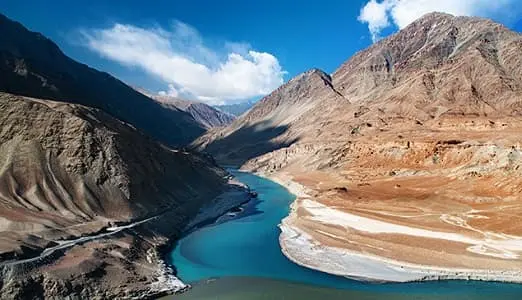The Indian subcontinent is blessed with a number of beautiful rivers. Most of the rivers start from the Himalayan region on the north of the country, The western ghats in the south, and from the Vindhya and Satpura ranges in the central part of India. Some of these rivers are bigger in comparison to global standards. The Ganges is the major and most famous river in India and is considered to be holy. There are numerous long rivers in India, running through many states and even countries, with a number of tributaries.
List of Longest Rivers in India
The top ten longest rivers in India are:
10. River Tapti
The river Tapti is also known as River Tapi and is the tenth longest river in India. It has a length of about 724 kilometers and originates from Bettul district in Madhya Pradesh. It drains through the Gulf of Khambat into the Arabian Sea. It flows in central India, through the states of Madhya Pradesh, Maharashtra and Gujarat.
The Ukai dam, constructed over the Tapti river is the second largest reservoir in Gujarat. The Tapti river runs from the east to the west and has great pre historic importance.
9. River Kaveri
The river Kaveri or Cauvery is an important river that flows through the states of Karnataka and Tamil Nadu. It is also known as the river Ponni. It has a length of 760 kilometers and is the third largest river in South India and the largest in Tamil Nadu. It originates in the foothills of the Western Ghats at Thalakaveri, in Coorg, Karnataka. The Kaveri delta is one of the most fertile areas in India. The river Kaveri drains into the Bay of Bengal.
The Kaveri river is also a sacred river and consists of major dams. The Kaveri Basin consists of many tributaries and covers three states and one union territory. This river is also a source of an extensive irrigation system and numerous hydroelectric projects.
8. River Mahanadi
The river Mahanadi is a major river in Eastern Central India and has a length of 890 kilometers. It flows through the states of Chattisgarh, Jharkhand and Odisha. Mahanadi originates from the Amarkantak plateau and drains into the Bay of Bengal. The Mahanadi Valley is famous for it’s fertility.
The Mahanadi river flows in a northerly direction and the famous Hirakud Dan is built across this river. Mahanadi itself means The great river. It is an active silt depositing stream and has highly fertile soil for agriculture. Numerous hydroelectric projects are also based on this river.
7. River Yamuna
The river Yamuna, locally known as Jamuna, is the second largest tributary of the Ganges river. It has a length of about 1211 kilometers. It originates from Gharwall in the Yamunotri glaciers and drains into the Bay of Bengal. It runs through many Indian states including Delhi and Allahabad. The river Yamuna is known for it’s reasonably good quality of water and has a number of tributaries.
The Yamuna river is highly sacred for the Hindus and is worshiped as Goddess Yamuna. It Is the second holiest river after the river Ganga. The river is highly polluted now due to rapid industrialization and population growth. The banks of the Yamuna river are home to a number of beautiful, historical monuments like the famous Taj Mahal in Agra.
6. River Krishna
The river Krishna is another famous river which is the fourth biggest river in terms of water inflows. It is also known as river Krishnaveni. It runs for a length of approximately 1300 kilometers. The Krishna river originates in the Western Ghats near Mahabaleshwar in Maharashtra at an elevation of about 1300 meters and is the main source of irrigation for the states of Maharashtra, Karnataka, Telangana and Andhra Pradesh. It flows through the south peninsular region of India and drains into the Arabian Sea at Hamasaladeevi in Andhra Pradesh. The delta of the Krishna river is one of the most fertile areas but causes severe soil erosion during the monsoon floods.
The Krishna river is believed to be sacred by the Hindus. Taking a bath in this river, is said to wash away all the impurities of a person and cleanse the soul of sins. The Krishna Pushkaram fair is held once in twelve years along the banks of the Krishna river. The Krishna river valley is also famous for a variety of flora and fauna.
5. River Narmada
The Narmada river is also known as River Rhewa and River Shankari. It has the same length as that of the River Krishna. It is a river in Central India and the third longest river that flows entirely through India. This river is known as the Life line of Gujarat and Madhya Pradesh. Narmada river originates from the Amarkantak plateau near Anuppur district in Madhya Pradesh and drains through the Gulf of Khambat into the Arabian Sea. The river Narmada is also famous for forming the traditional boundary between South India and North India.
The Narmada river is one of the only three major rivers in peninsular India. It flows in a rift Valley between the Satpura and Vindhya ranges. Narmada is a Sanskrit word, which means, Giver of pleasure.
4. River Godavari
The River Godavari is the longest river in India after the Ganga. It originates in the Nasik Hills at Triambakeshwar in Maharashtra and flows for a length of 1450 kilometers. It forms one of the largest river basins in India and drains into the bay of Bengal. The river Godavari is also known as the Ganges of the South. It flows through the states of Maharashtra, Telangana, Chattisgarh, Andhra Pradesh and Pondicherry.
This river is respected by the Hindus and is said to nourish a rich cultural heritage. The river also has a number of pilgrim centers on it’s banks.
3. River Ganga
The river Ganga is the most famous river is India and is considered to be holy. It is visited by tourists from around the world. It is popular known as the Ganges. It is a transfer boundary river and flows through the states of India and Bangladesh. It originates from the western Himalayas in the Indian state of Uttarakhand and flows through the Gangetic plain of North India. It divides into two prominent rivers, the Hooghly river and the Padma river. The Ganges is the third largest river in the world, in terms of water discharge. It has a great length of 2510 kilometers and drains into the Bay of Bengal. It mainly flows through Uttar Pradesh, Uttarakhand, Bihar and West Bengal.
The Ganga is the most sacred river of the Hindus and was revered in the ancient scriptures. The river is worshipped as Goddess Ganga. It is a famous river for dissolving the ashes as it is said to relieve one of all sins, when bathed in this river. The river is highly polluted now which is a threat to humans and many river species including the endangered Gangetic dolphins.
2. River Brahmaputra
The river Brahmaputra is one of the major trans boundary rivers in Asia. It is known by different names in different regions. It flows through the countries of China, India and Bangladesh and has a length of 2900 kilometers. It arises from the lake Manasarovar region in the northern side of the Himalayas in Tibet and flows into Arunachal Pradesh in India. The second longest river in India, the Brahmaputra is an important river for irrigation and transportation. It mainly flows through the North Eastern states of India and drains into the Bay of Bengal.
The Brahmaputra river is prone to highly catastrophic flooding during the melting if the Himalayan glaciers. Certain parts of the river is considered holy by the Hindus and this river Basin is characterized by high levels of rainfall.
1. River Indus

The Indus river is the longest river in India with a length of 2900 kilometers. The Indus river is also one of the longest rivers in Asia and is commonly known as the Sindhu river. It originates from the Kailash plateau of the Tibetan range in the vicinity of Lake Manasarovar. It runs through India and Pakistan and drains into the Arabian Sea near Karachi in Sindh. It is the national river of Pakistan and also the longest river of Pakistan. The northern part of the Indus Valley forms the Punjab region with all it’s tributaries. The lower part of the Indus Valley is known as Sindh and forms into a large delta.
The Indus river is of utmost importance in history and the name India is derived from Indus.
Conclusion
India is blessed with a number of rivers. Most of the rivers drain into the Arabian sea and the Bay of Bengal. These rivers form several deltas which are highly fertile regions and hence play an important role in agriculture and cultivation. They also possess a number of tributaries and help in irritation and transportation processes and are an important source of water.
Santosh Kumar, the author behind IndiasStuffs.com, is passionate about sharing valuable insights on a variety of topics, including lifestyle, technology, and Indian culture.
Page Contents

